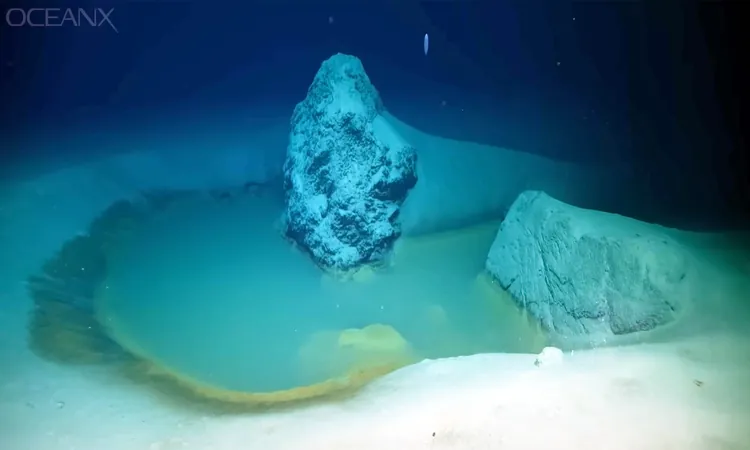
Unveiling Life's Extremes: Surprising Discovery at the Bottom of the Red Sea
2025-05-02
Author: Li
An Astonishing Find Beneath the Red Sea
Deep within the crystal-clear waters of the Gulf of Aqaba, researchers have uncovered extraordinary brine pools, where hyper-salty water behaves more like syrup than seawater. These hidden underwater lakes resist mingling with the surrounding ocean, creating a toxic chemical cauldron that's inhospitable to most marine life.
A Groundbreaking Discovery
An OceanX expedition, employing a remotely operated underwater vehicle from the research vessel OceanXplorer, made this remarkable discovery just an hour from the Saudi coastline. This unexpected revelation challenges everything we thought we knew about the locations and formation of brine pools, traditionally found far offshore in places like the central Red Sea or the Gulf of Mexico.
The Science of Brine Pools
Brine pools emerge when subsurface salt formations dissolve and rise to create natural basins. Because this salty water is denser than regular seawater, it remains trapped, crafting its own unique underwater landscapes and currents. These extreme conditions, characterized by high salinity and zero oxygen, sustain bizarre microbes that thrive in environments uninhabitable for most sea creatures.
A Close Encounter with History
The proximity of these pools—merely 1.2 miles from shore—was a surprising twist since previous formations were found much deeper in the ocean. The current pools act as historical time capsules, capturing sediments from natural events like floods and tsunamis that funnel into them. Sam Purkis, a marine scientist from the University of Miami, expressed excitement at the find, which came in the final minutes of a lengthy ROV dive, allowing the team to gather critical samples for further analysis.
Recording the Past in Sediment
Researchers drilled over 10 feet into the sediment of the largest pool, revealing layers of history dating back over 1,200 years. These layers tell stories of underwater landslides, flash floods, and even tsunami activity. Notably, one specific layer matched debris from a significant underwater upheaval that occurred about 500 years ago, potentially prompting destructive waves along the Egyptian and Saudi coastlines.
Intriguing Life Forms
Despite the challenges posed by the harsh environments, signs of life flourish at the fringes of these brine pools. Schools of shrimp and predatory eels navigate the salinity boundary, while remote cameras captured footage of deep-sea creatures like dogfish venturing into this unusual habitat. Microbiologists are particularly keen on exploring the distinct microbes found here, as similar environments have previously revealed potential cancer-fighting compounds.
Brine Pools: A Clue to Extraterrestrial Life?
Purkis highlighted the significance of these discoveries in the context of astrobiology, emphasizing that understanding how life adapts in such extreme conditions on Earth can illuminate the search for extraterrestrial life on other planets, particularly in harsh environments like Europa or Enceladus.
Implications for Future Research and Infrastructure
The study, published in Communications Earth & Environment, has broader implications for understanding Earth's geological history. The brine pools act as natural records of seismic activity, helping scientists to devise better risk assessments and infrastructure planning in the region.
Looking Ahead
Future expeditions aim to delve deeper into these remarkable brine environments, investigating how microbes respond to sudden changes. Each new sample brings us closer to redefining the parameters of life and enhances our understanding of both Earth and the cosmos. Stay tuned for more revelations from this underexplored frontier!


 Brasil (PT)
Brasil (PT)
 Canada (EN)
Canada (EN)
 Chile (ES)
Chile (ES)
 Česko (CS)
Česko (CS)
 대한민국 (KO)
대한민국 (KO)
 España (ES)
España (ES)
 France (FR)
France (FR)
 Hong Kong (EN)
Hong Kong (EN)
 Italia (IT)
Italia (IT)
 日本 (JA)
日本 (JA)
 Magyarország (HU)
Magyarország (HU)
 Norge (NO)
Norge (NO)
 Polska (PL)
Polska (PL)
 Schweiz (DE)
Schweiz (DE)
 Singapore (EN)
Singapore (EN)
 Sverige (SV)
Sverige (SV)
 Suomi (FI)
Suomi (FI)
 Türkiye (TR)
Türkiye (TR)
 الإمارات العربية المتحدة (AR)
الإمارات العربية المتحدة (AR)